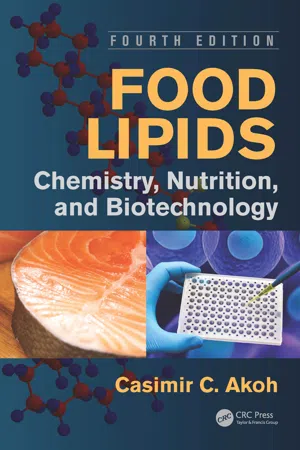I. Definitions of Lipids
II. Lipid Classifications
A. Standard IUPAC Nomenclature of Fatty Acids
B. Common (Trivial) Nomenclature of Fatty Acids
C. Shorthand (ω, n-) Nomenclature of Fatty Acids
III. Lipid Classes
A. Fatty Acids
1. Saturated Fatty Acids
2. Unsaturated Fatty Acids
3. Acetylenic Fatty Acids
4. Trans Fatty Acids
5. Branched Fatty Acids
6. Cyclic Fatty Acids
7. Hydroxy and Epoxy Fatty Acids
8. Furanoid Fatty Acids
B. Acylglycerols
C. Sterols and Sterol Esters
D. Waxes
E. Phosphoglycerides (Phospholipids)
F. Ether(Phospho)Glycerides (Plasmalogens)
G. Glyceroglycolipids (Glycosylglycolipids)
H. Sphingolipids
I. Fat-Soluble Vitamins
1. Vitamin A
2. Vitamin D
3. Vitamin E
4. Vitamin K
J. Hydrocarbons
IV. Summary
References
No exact definition of lipids exists. Christie [1] defines lipids as “a wide variety of natural products including fatty acids and their derivatives, steroids, terpenes, carotenoids, and bile acids, which have in common a ready solubility in organic solvents such as diethyl ether, hexane, benzene, chloroform, or methanol.”
Kates [2] says that lipids are “those substances which are (a) insoluble in water; (b) soluble in organic solvents such as chloroform, ether or benzene; (c) contain long-chain hydrocarbon groups in their molecules; and (d) are present in or derived from living organisms.”
Gurr and James [3] point out that a standard definition describes lipids as “a chemically heterogeneous group of substances, having in common the property of insolubility in water, but solubility in nonpolar solvents such as chloroform, hydrocarbons or alcohols.”
Despite its common usage, definitions based on solubility have obvious problems. Some compounds that are considered as lipids, such as C1–C4 very short-chain fatty acids (VSCFAs), are completely miscible with water and insoluble in nonpolar solvents. Some researchers have accepted this solubility definition strictly and exclude C1–C3 fatty acids from the definition of lipids, keeping C4 (butyric acid) only because of its presence in dairy fats. Additionally, some compounds that are considered as lipids, such as some trans fatty acids (those not derived from bacterial hydrogenation), are not derived directly from living organisms. The development of synthetic acaloric and reduced calorie lipids such as the sucrose polyester olestra (trade name Olean®) complicates the issue because these lipids may fit into solubility-based definitions but are not derived from living organisms, may be acaloric, and may contain esters of VSCFAs.
The traditional definition of total fat of foods used by the U.S. Food and Drug Administration (FDA) has been “the sum of the components with lipid characteristics that are extracted by Association of Official Analytical Chemists (AOAC) methods or by reliable and appropriate procedures.” The FDA has changed from a solubility-based definition to “total lipid fatty acids expressed as triglycerides” [4], with the intent to measure caloric fatty acids. Solubility and size of fatty acids affect their caloric values. This is important for products that take advantage of the calorie-based definition, such as Benefat/Salatrim, so these products would be examined on a case-by-case basis. Food products containing sucrose polyesters would require special methodology to calculate caloric fatty acids. Foods containing vinegar (~4.5% acetic acid) present a problem because they will be considered to have 4.5% fat unless the definition is modified to exclude water-soluble fatty acids or the caloric weighting for acetic acid is lowered [4].
Despite the problems with accepted definitions, a more precise working definition is difficult, given the complexity and heterogeneity of lipids. This chapter introduces the main lipid structures and their nomenclature.
II. LIPID CLASSIFICATIONS
Classification of lipids is possible based on their physical properties at room temperature (oils are liquid and fats are solid), polarity (polar and neutral lipids), essentiality for humans (essential and nonessential fatty acids), or structure (simple or complex). Neutral lipids include fatty acids, alcohols, glycerides, and sterols, whereas polar lipids include glycerophospholipids and glyceroglycolipids. The separation into polarity classes is rather arbitrary, as some short-chain fatty acids are very polar. A classification based on structure is, therefore, preferable.
Based on structure, lipids can be classified as derived, simple, or complex. Derived lipids include free fatty acids and alcohols, which are the building blocks for the simple and complex lipids. Simple lipids, composed of fatty acids and alcohol components, include acylglycerols, ether acylglycerols, sterols, and their esters and wax esters. In general terms, simple lipids can be hydrolyzed to two different components, usually an alcohol and an acid. Complex lipids include glycerophospholipids (phospholipids), glyceroglycolipids (glycolipids), and sphingolipids. These structures yield three or more different compounds on hydrolysis.
The fatty acids constitute the obvious starting point in lipid structures. However, a short review of standard nomenclature is appropriate. Over the years, a large number of different nomenclature systems have been proposed [5]. The resulting confusion has led to a need for nomenclature standardization. The International Union of Pure and Applied Chemists (IUPAC) and International Union of Biochemistry (IUB) collaborative efforts have resulted in comprehensive nomenclature standards [6], and the nomenclature for lipids has been reported [7,8 and 9]. Only the main aspects of the standardized IUPAC nomenclature relating to lipid structures will be presented; greater detail is available elsewhere [7,8 and 9].
Standard rules for nomenclature must take into consideration the difficulty in maintaining strict adherence to structure-based nomenclature and elimination of common terminology [5]. For example, the compound known as vitamin K1 can be described as 2-methyl-3-phytyl-1,4-naphthoquinone. Vitamin K1 and many other trivial names have been included into standardized nomenclature to avoid confusion arising from long chemical names. Standard nomenclature rules will be discussed in separate sections relating to various lipid compounds.
Fatty acid terminology is complicated by the existence of several different nomenclature systems. The IUPAC nomenclature, common (trivial) names, and shorthand (n- or ω) terminology will be discussed. As a lipid class, the fatty acids are often called free fatty acids (FFAs) or nonesterified fatty acids (NEFAs). IUPAC has recommended that fatty acids as a class be called fatty acids and the terms FFA and NEFA eliminated [6].
A. STANDARD IUPAC NOMENCLATURE OF ...
